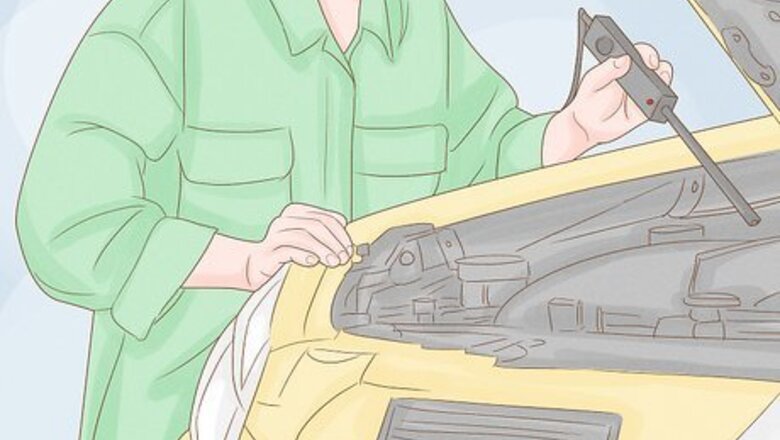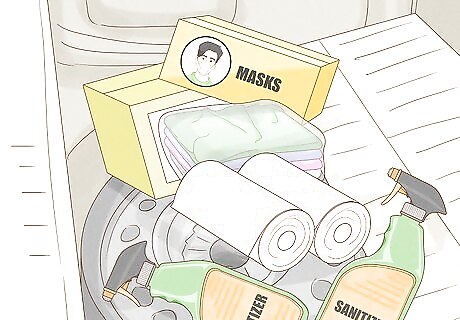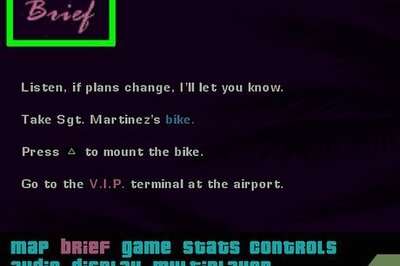
views
Car Prep

Get your car inspected and serviced before hitting the road. Stop by your local mechanic or auto shop for a tune-up. Ask them to do an oil change and take a look at your car’s brakes, coolant, brake fluid, and wiper fluid, along with the car’s hoses, belts, air filters, radiator, and battery. Your mechanic can address and fix any potential issues beforehand, so your car is primed and ready to go for the big trip. Well-established organizations, like the American Automobile Association (AAA) can check out your car before a road trip.

Fill up your tires to the recommended psi. Flip through your car’s user manual to find the recommended PSI (pounds per square inch) rating for your tires—essentially, this is a fancy term for how much air your tires need. Grab a tire gauge and see how much air is currently in your tires. If your tires are a little under the recommended PSI level, fill them up with an air pump. Many gas stations have air pumps you can use for a small fee. For a more accurate reading, check your tires when they’re cold. Some cars might list the recommended psi on a sticker in the door jamb, or the inside of the car door. However, not all vehicles do this.

Stow a sturdy spare tire and tire changing supplies in the back of the car. Even the most careful drivers can run into tire trouble during a long trek. Grab a tire gauge and check the spare tire’s psi level to make sure it’s up-to-snuff with the rest of your car. Store a lug or torque wrench and tire jack in your car along with the spare, so you can change the tire if need be. You can find your car’s recommended tire psi levels in the car user manual.

Clean out your car before hitting the road. Toss out any old junk or trash that’s cluttering up your car, like old food wrappers, cups or receipts. Search through your trunk and take out anything you don’t need—chances are, you’ll need a lot of space for luggage and potential souvenirs, anyway. Vacuum any crumbs and dirt from your floor mats, and give your dashboard, steering wheel, cup holders, and other high-touch surfaces a good wipe-down before the trip. If you’d like to go the extra mile, wash off any extra dirt or other gunk from the outside of your car, too.

Adjust your seat and mirrors before starting your trip. Lift up your seat a little bit, so your hips are above your knees. Pull your seat forward so you can grab the steering wheel comfortably. Once your seat is primed and ready to go, tweak your side and rearview mirrors so you can see out of them clearly. Some car seats don’t offer a lot of back support. In this case, you can give your back a little boost with a rolled-up towel or small pillow.

Replace your windshield wipers if they look worn down. Turn your windshield wipers on during a rainy day and see how much rain they actually clear away. If your blades are a little streaky, or if they’re missing some major spots, it might be time for a replacement. Measure your current wipers to get an idea of what size you need, then pick up some replacements at an auto supply shop. Your car’s user manual might have some useful information on what type of wipers you need.

Store up-to-date paperwork in your glove compartment. Double-check that your car’s registration is up-to-date and easy to find. As an extra precaution, stash your car’s insurance paperwork in the glove compartment as well.
Route Planning

Map out your route ahead of time. Whether you've got a single destination in mind or want to make lots of stops, figure out what route you'll take ahead of time. There tons of tools and apps that can help you choose the best route based on what you want to see and where you're headed. Check out Roadtrippers, for example, to find lots of cool spots to check out along the way.

Limit yourself to 8 hours of driving a day. It may be tempting to drive until you reach your destination, but this isn’t a very realistic goal. Instead, drive for about 8 hours each day, pausing for a 15-minute back every 2 hours. This adds up to about 500 mi (800 km). Your travel time may also depend on who’s in the car with you. If you run into heavy traffic, you may not get as far in 1 day.

Choose your rest stops before hitting the road. Once you have your route set in stone, look for some gas stations, convenience stores, or other rest stops along the way. Plan out where you’d like to stop along your journey, so you don’t have to worry about finding a gas station while you’re on the road. Driving can be really exhausting, especially if you’re adventuring on a long road trip. There’s nothing wrong with parking at a rest stop and taking a quick nap!

Make reservations ahead of time if you’re staying somewhere. Look for hotels, campgrounds, airbnbs, or other places where you can stop and rest along your journey. Call ahead of time to book a room—there’s always a chance that a hotel or inn will be sold out by the time you arrive.

Stop to stretch for 15 minutes once every 2-3 hours. Long car rides can take a toll on your muscles, and leave you feeling tense and uncomfortable. Pull over at a rest stop to give yourself time to stretch, and get your blood circulating. While you’re out of the car, walk around for 5 minutes to stretch your legs. For a simple stretch, lift your arms up over your head while keeping your feet planted on the ground. Extend your arms for about 20 seconds, and then relax.

Budget for the gas and hotel prices along your route. Gas prices are pretty fickle and might be a bit more pricey in different areas. Search online to see what the going gas and lodging rates along your pre-decided route are. Depending on where you’re going, you may need to set aside a little extra money for fueling and lodging. Apps like GasBuddy and iExit can help you find inexpensive gas stations in the area. For example, you might budget $200 for gas, $450 for a 2-night stay at a hotel, and $150 for food.

Call or check ahead to make sure your destination is open. With the COVID-19 pandemic, certain tourist spots are closed, or have more limited hours. Go online or call the destination to see what their hours are, and if they’ll be open during your road trip.

Practice safe and sanitary habits to prevent the spread of COVID-19. COVID-19 makes road trips a bit more challenging, but don’t worry—there are plenty of workarounds. Bring your own sheets and towels if you’re staying at a hotel or Airbnb, and use hand sanitizer frequently when you’re on the road. If you stop for food, choose a restaurant that offers curbside or contactless pick-up. There’s nothing wrong with using a public restroom while you’re on the road! Just be sure to wear a mask, and sanitize your hands after using the facilities.
What to Pack

Pack plenty of clothing and toiletries for your road trip. Bring along plenty of comfortable clothing, depending on when you’re traveling. Additionally, pack along a first-aid kit, along with any prescription or over-the-counter medicines you might need while on your trip. If you have any special medical conditions, bring along a medical alert bracelet, as well as any other supplies you might need, like an EpiPen or inhaler. Double check to make sure you have everything you need. For instance, if you’re traveling in the summer, you’ll want to bring along flip-flops, swimming gear, and a visor. If you’re traveling in the winter, you’ll want a heavy coat, along with insulating clothes that will keep you warm.

Stay entertained while you’re on the road. Road trips can get a little boring after awhile, even if you’re traveling with friends or relatives. Download plenty of podcasts, audiobooks, or music to your phone, so you can stay entertained for hours at a time. If you’re traveling with someone else, bring a simple game with you, like Mad Libs. Podcasts are great to put on if you have to drive for a long stretch of the trip.

Bring an emergency kit with you. Pack a phone charger, road flares, a flashlight, jumper cables, a reflective vest, first-aid kit, a tire jack, lug or torque wrench, and a fire extinguisher before you hit the road. If you’re traveling in cold weather, bring along plenty of blankets and gloves, along with an ice scraper, sand bags, extra drinking water, paper towels, and a small shovel. Screwdrivers, pliers, and other simple tools are also good to have on hand. Pack a small wooden board in your emergency kit—this will help keep your car balanced if you have to change your tires in a precarious spot.

Bring identity documents, cash and a credit card along with you. Road trips aren’t as pricey as flights, but fuel, lodging, and food can add up after a while. Bring some extra cash in your wallet, along with a debit or credit card so you can tackle any of these extra costs. During the COVID-19 outbreak, contactless payments are the safest way to go. Try to pay with card instead of cash, or using a phone-based payment. You will need to take a passport or passport card with you if you will be crossing international borders. Make sure that your passport is unexpired, with all the required visas obtained from the government’s embassy or consular offices, and that everyone traveling with you has a passport. You must stop at a border checkpoint if you cross an international border. In some cases, you must also stop at a border checkpoint if entering or leaving a province of a country, to avoid the introduction of pests to that province. Print and fill out a customs form before you start your road trip to save yourself headaches later upon arriving at the US-Canada border. In some cases, you may be allowed to pass through a country without obtaining a passport to reach another location in your own country. For example, you may be allowed to cross into Canada from the United States if traveling to or from Alaska, or to reach a destination along the US-Canada border.

Pack some extra toys if you’re traveling with young kids. Road trips are exhausting for everyone involved, especially little ones who have a short attention span. Pack along some extra toys, books, and other fun activities that can keep your children distracted and entertained during the trip. You can keep them interested and entertained by pointing out cool signs and sights along the road. Sing-along songs are a great way to keep your little ones interested along the trip.

Store your luggage in the trunk the day before you leave. Place your heavier luggage along the bottom of the trunk, so it doesn’t go flying. If your luggage is especially heavy, strap it down with cargo anchors. Try to get all of your packing done the day or night before, so you don’t have to worry about it the day you leave. Always keep your heaviest items on the bottom of the trunk. If you need to brake suddenly, you don’t want any heavy items flying to the front of the car. You can store your things on the top of your car, but this can slow your vehicle down. Don’t pack your luggage up to the roof of your car—you need to be able to see behind you while you’re driving.

Pack snacks and food for your trip. Keep your food in an easy-to-reach area, so everyone can snack throughout the trip. Pack any perishable food in a portable cooler that’s easy to access, in case there isn’t time to stop by a restaurant or eating area. Pick out food that won’t be messy to eat, like frozen grapes, snack mix, or squeezable applesauce.

Stash sanitary supplies in the car. Store a few extra face masks in your car, along with hand sanitizer and plastic gloves. Wear a mask whenever you’re out in public, like a rest stop or restaurant. As an extra precaution, slip on a pair of plastic gloves before filling up your car with gas.


















Comments
0 comment